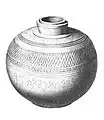魯庫娜聖物箱
魯庫娜聖物箱,(Rukhuna 或 Rukhana reliquary)有時被稱為巴焦爾聖物箱銘文(Bajaur reliquary inscription),是塞種人聖物箱,它在公元16年時被一位名為魯庫娜的王后所供奉著,魯庫娜她是印度-塞種阿帕拉卡王國(Apracharajas)國王維傑亞米特拉(Vijayamitra)的王后。聖物箱中銘文在2005年時由學者薩洛蒙(Richard G. Salomon)透過照片發表公布[1],銘文中提到三種紀年方式,幫助學術界釐清北印度紀年方式之間的關係,尤其是確定了耶槃那紀年比阿澤斯紀年(Azes era)早128年的關聯[2][3]。
| 文字 | 佉盧文 |
|---|---|
| 材質 | 磨亮後的灰色片岩.[1] |
| 尺寸 | 16x16 公分[1] |
| 所屬年代 | 16 CE |
銘文
這段銘文對於這時期紀年方式的釐清非常有幫助,銘文為[4][5][6]:
| 佉盧文原文 | 轉寫 | 漢譯 |
|---|---|---|
| 𐨬𐨮𐨩𐨅 𐨯𐨟𐨬𐨁𐨭𐨩𐨅 𐩅 𐩃 𐩀 𐩀 𐩀 𐨀𐨁𐨭𐨿𐨤𐨪𐨯 | 在第27年屬於殿下- | |
| 𐨬𐨁𐨗𐨩𐨨𐨁𐨟𐨿𐨪𐨯 𐨀𐨤𐨕𐨪𐨗𐨯 𐨀𐨞𐨂𐨭𐨯𐨿𐨟𐨁𐨩𐨅 𐨩𐨅 𐨬𐨂𐨕𐨟𐨁 𐨀𐨩𐨯 | 阿帕拉卡國王維傑亞米特拉的統治,在被稱之阿澤斯的- | |
| 𐨬𐨮𐨩𐨅 𐨟𐨿𐨪𐨅𐨯𐨟𐨟𐨁𐨨𐨀𐨅 𐩅 𐩅 𐩅 𐩄 𐩀 𐩀 𐩀 𐨩𐨆𐨞𐨞 𐨬𐨮𐨩𐨅 𐨀𐨅𐨐𐨡𐨂𐨭𐨟𐨁𐨨𐨩𐨅 | 第73年,在臾那人的- | |
| 𐩀 𐩀 𐩆 𐩀 𐨭𐨿𐨪𐨬𐨞𐨯 𐨨𐨯𐨯 𐨡𐨁𐨬𐨯𐨩𐨅 𐨀𐨛𐨨𐨩𐨅 𐨀𐨁𐨭 𐨡𐨁𐨬𐨯𐨎𐨨𐨁 𐨤𐨿𐨪𐨟𐨁𐨳𐨩𐨁𐨡𐨂 𐨠𐨂𐨬𐨅 | 第201年,於室羅伐拏月的第八天,在這一天這窣堵坡被捐造,由- | |
| 𐨪𐨂𐨑𐨂𐨞𐨩𐨅 𐨀𐨤𐨕𐨪𐨗𐨧𐨪𐨿𐨩𐨀𐨅 𐨬𐨁𐨗𐨩𐨨𐨁𐨟𐨿𐨪𐨅𐨞 𐨀𐨤𐨿𐨪𐨕𐨪𐨗𐨅𐨞 𐨀𐨁𐨎𐨡𐨿𐨪𐨬𐨪𐨿𐨨𐨅𐨞 𐨯𐨿𐨟𐨿𐨪𐨟𐨅𐨒𐨅𐨞 𐨯𐨧𐨪𐨿𐨩𐨪𐨅𐨱𐨁 𐨯𐨐𐨂𐨨𐨪𐨅𐨱𐨁 | 阿帕拉卡國王的妻子魯庫娜、阿帕拉卡國王維傑亞米特拉、將軍英德拉瓦曼、和他們的妻兒們等人 |
在銘文中的臾那人為希臘人,即耶槃那紀年。原文中明確提到耶槃那紀年和阿澤斯紀年以及其年份數字,可以得到兩種紀年之間的相對關聯,確定了耶槃那紀年比阿澤斯紀年早128年。同時因為銘文中提到該年是國王維傑亞米特拉統治的第27年,因此也可以斷定他是從公元前12年開始統治,幫助學術界釐清印度-塞種王國年表有很大幫助。銘文也說明印度-塞種王國受希臘文化影響,佉盧文原文中英德拉瓦曼的官稱是strategeṇa,這詞很可能來自古希臘文中的將軍(Strategos)。另外,王后魯庫娜和國王維傑亞米特拉奉獻等行為,很可能他們都皈依了佛教。
在2005年時由學者薩洛蒙發表後,学术界几乎一致接受魯庫娜聖物箱和銘文的真实性,僅有學者杰拉德·福斯曼(Gérard Fussman)提出异议[10]。
其他類似的聖物箱

 在比马兰舍利盒(Bimaran casket)中,銘文是刻在外部而不是在內部。
在比马兰舍利盒(Bimaran casket)中,銘文是刻在外部而不是在內部。
 從阿伊-哈努姆遺址中,在神殿內聖所壁龛出土的石制容器(pyxis),前三世紀-前二世紀文物.[11]
從阿伊-哈努姆遺址中,在神殿內聖所壁龛出土的石制容器(pyxis),前三世紀-前二世紀文物.[11]
注腳
- Salomon, Richard. . Brepols. 2005: 359–400 [2022-01-29]. ISBN 978-2-503-51681-3. (原始内容存档于2022-01-29).
- Des Indo-Grecs aux Sassanides: données pour l'histoire et la géographie historique, Rika Gyselen, Peeters Publishers, 2007, p.109 (页面存档备份,存于)
- Mac Dowall, David W. . Peeters Publishers. 2007: 103–110. ISBN 9782952137614 (英语).
- . Journal of the Institute of Silk Road Studies, Kamakura (The Institute). 2003, 9: 49 [2022-01-29]. (原始内容存档于2021-10-24) (英语).
- Baums, Stefan. 2012. “Catalog and Revised Texts and Translations of Gandharan Reliquary Inscriptions.” In David Jongeward, Elizabeth Errington, Richard Salomon and Stefan Baums, Gandharan Buddhist Reliquaries. Gandharan Studies, Volume 1, pp. 200–51. Seattle: Early Buddhist Manuscripts Project.
- Fussman, Gérard. (PDF). : 242 [2022-01-29]. (原始内容存档 (PDF)于2021-12-07).
- Baums, Stefan. (2012). Catalog and Revised Text and Translations of Gandhāran Reliquary Inscriptions. Gandhāran Buddhist Reliquaries. D. Jongeward. Seattle, University of Washington Press
- "Afghanistan, carrefour en l'Est et l'Ouest" p.373. Also Senior 2003
- Des Indo-Grecs aux Sassanides, Rika Gyselen, Peeters Publishers, 2007, p.103
- Fussman, Gérard. (PDF). : 239–259 [2022-01-29]. (原始内容存档 (PDF)于2021-12-07).
- Falk, Harry. . 2015: 135 [2022-01-29]. (原始内容存档于2022-01-29) (英语).
參考來源
- Baums, Stefan. 2012. “Catalog and Revised Texts and Translations of Gandharan Reliquary Inscriptions.” In: David Jongeward, Elizabeth Errington, Richard Salomon and Stefan Baums, Gandharan Buddhist Reliquaries, pp. 212–213, Seattle: Early Buddhist Manuscripts Project (Gandharan Studies, Volume 1).
- Baums, Stefan, and Andrew Glass. 2002– . Catalog of Gāndhārī Texts (页面存档备份,存于), nos. CKI 405 (页面存档备份,存于)
- Senior, R.C. . Classical Numismatic Group, Inc. 2006. ISBN 0-9709268-6-3.
- Richard SALOMON, "A New Inscription dated in the "Yona" (Greek) Era of 186/5 B.C." in Afghanistan, ancien carrefour entre l'est et l'ouest, O. Bopearachchi, M.-F. Boussac (eds.), 2005, ISBN 978-2-503-51681-3 Languages: French, English (页面存档备份,存于)
This article is issued from Wikipedia. The text is licensed under Creative Commons - Attribution - Sharealike. Additional terms may apply for the media files.